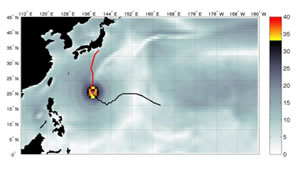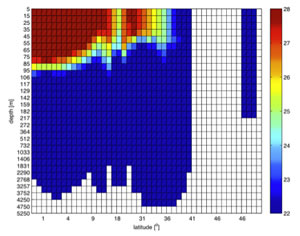Tropical Cyclones in Coupled General Circulation Models
By Enrico Scoccimarro
Could Coupled GCMs help in improve our understanding of the Tropical Cyclones-Ocean interaction?
Motivation
The ocean response to the storm forcing and the influence of the ocean variability on TCs development are challenging issues to better understand the coupled ocean–atmosphere system. Coupled General Circulation Models are an advanced tool to investigate the full extent of TC induced feedbacks at the surface of the ocean.
Research Summary
The wind activity associated with tropical cyclones is responsible for two atmosphere-ocean feedbacks (Bender et al.1993, 2000) that can be both represented by CGCMs: the first, positive, is driven by the latent heat associated with the strengthened evaporation rate and leads to an increase of the available energy for TC development (Riehl 1950, Kleinschmidt 1951); the second, negative, is due to the cold water upwelling induced by the increased wind stress at the ocean surface and to the shear-induced mixing at the base of the mixed layer (Jansen et al., 2010). There is also evidence that TCs have a role in modulating the meridional heat transport in the northern hemisphere through their interplay with oceans [Emanuel, 2001; Sriver et al., 2007] affecting the climate system [Hu and Meehl, 2009; Fedorov et al., 2010; Sriver, 2010]. This TC effect on the ocean can be represented also through high resolution CGCMs [Scoccimarro et al., 2011].
Implications
Strong TCs have a greater potential to make landfall at higher intensities, thus a good representation of TCs intensity over the ocean is a key issue to be addressed. The sea surface temperature (SST) feedback generally leads to a weakening of the cyclone intensity due to the reduction of the total heat flux into the atmosphere (Schade and Emanuel 1999, Chan et al. 2001). The SST reduction beneath a moving TC is mainly due to the entrainment from the deep ocean, while surface flux interactions play a minor role (Price 1981). Thus the amount of energy available for TC intensification depends on the SST and CGCMs provide a realistic evolution of this boundary condition in time and space, during the storm development. In Figure 2 the Temperature doming below a strong TC (Figure 1), modelled by a state of the art fully Coupled General Circulation model is shown; the revealed induced cooling at the surface of the ocean is about 2C.

Figure 1. 10meter wind speed during the passage of a strong TC as simulated by a CGCM with an atmospheric resolution of about 80 Km and an ocean resolution of about 100 Km. Colors indicate where hurricane intensity is reached. Units are [m/s].

Figure 2. Temperature section (longitude=143E) 1 day after the passage of the Tropical Cyclone shown in figure 1. Units are [degrees C]
Future Work
A good representation of TCs in CGCMs depends mainly on atmospheric spatial resolution (Bengtsson et al. 2007, Gualdi et al. 2008, Murakami et al. 2010). To better represent the TC-Ocean Interaction, also the resolution of the Ocean models involved in the coupled system plays an important role and needs to be improved to simulate local and short term processes at the surface.
References
- Bender M.A., I. Ginis, and Y. Kurihara, 1993: Numerical simulations of tropical cyclone–ocean interaction with a high resolution coupled model. J. Geophys. Res., 98, 23 245–23 263.
- Bender, M.A., and I. Ginis, 2000: Real case simulations of hurricane-ocean interaction using a high resolution coupled model: Effects on hurricane intensity. Mon. Wea. Rev., 128, 917-946.
- Bengtsson, L. et al., 2007: How may tropical cyclones change in a warmer climate. Tellus 59A, 539–561.
- Chan J.C.L.,Y. Duan and L. K. Shay, 2001: Tropical cyclone intensity change from a simple ocean–atmosphere coupled model. J. Atmos. Sci., 58, 154–172.
- Emanuel K.A., 2001: Contribution of tropical cyclones to meridional heat transport by the oceans, Journal of Geophysical Research, 106 (D14), 14,771–14,781.
- Fedorov A.V., C.M. Brierley, K. Emanuel, 2010: Tropical cyclones and permanent El Nino in the early Pliocene epoch. Nature, 463, 1066-1070.
- Gualdi S., E. Scoccimarro, A. Navarra, 2008: Changes in Tropical Cyclone Activity due to Global Warming: Results from a High-Resolution Coupled General Circulation Model. J. of Clim., 21, 5204–5228.
- Hu A. and G. A. Meehl, 2009: Effect of the Atlantic hurricanes on the oceanic meridional overturning circulation and heat transport. Geophys. Res. Lett, 36, L03702, doi:10.1029/2008GL036680.
- Jansen M, R. Ferrari, T.A. Mooring, 2010: Seasonal versus permanent thermocline warming by tropical cuclones. Geophys. Res. Lett, 37, L03602, doi:10.1029/2009GL041808.
- Kleinschmidt E. Jr., 1951: Grundlagen einer Theorie der tropischen Zyklonen. Arch. Meteor. Geophys. Bioklimatol., 4A, 53–72.
- Murakami, H. and M. Sugi, 2010: Effect of model resolution on tropical cyclone climate projections, SOLA, 6, 73-76.
- Price J. F., 1981: Upper ocean response to a hurricane. J. Phys. Oceanogr. 11, 153–175.
- Riehl H., 1950: A model of hurricane formation. J. Appl. Phys., 21, 917-925.
- Schade L. R. and K. A. Emanuel, 1999: The ocean’s effect on the intensity of tropical cyclones: Results from a simple coupled atmosphere–ocean model. J. Atmos. Sci., 56, 642– 651.
- Scoccimarro E., S. Gualdi, A. Bellucci, A. Sanna , P.G. Fogli,E. Manzini, M. Vichi, P. Oddo, A. Navarra, 2011: Effects of Tropical Cyclones on Ocean Heat Transport in a High Resolution Coupled General Circulation Model. J. of Clim. doi: 10.1175/2011JCLI4104.1.
- Sriver R. L. and M. Huber, 2007: Observational evidence for an ocean heat pump induced by tropical cyclones, Nature, 447, 577 – 580, doi:10.1038/nature05785.
- Sriver R. L., 2010: Tropical cyclones in the mix. Nature, 463, 1032-1033.
